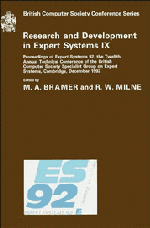Book contents
- Frontmatter
- Contents
- Preface
- Introduction
- CONSULTANT: providing advice for the machine learning toolbox
- A methods model for the integration of KBS and conventional information technology
- KBS methodology as a framework for co-operative working
- Project management for the evolutionary development of expert systems
- The specification and development of rule-based expert systems
- Towards a method for multi-agent system design
- Jigsaw: configuring knowledge acquisition tools
- On the relationship between repertory grid and term subsumption knowledge structures: theory practice tools
- Strategy maze: an on-line tool for support management of the knowledge acquisition process
- Concurrent engineering using collaborating truth maintenance systems
- Ockham's razor as a gardening tool
- A designer's consultant
- Fairness of attribute selection in probabilistic induction
- An application of case-based expert system technology to dynamic job-shop scheduling
- Neural network design via LP
- KEshell2: an intelligent learning data base system
- Approaches to self-explanation and system visibility in the context of application tasks
- An object oriented approach to distributed problem solving
- Intelligent user interface for multiple application systems
- Combining qualitative and quantitative information for temporal reasoning
- Documents as expert systems
Jigsaw: configuring knowledge acquisition tools
Published online by Cambridge University Press: 04 August 2010
- Frontmatter
- Contents
- Preface
- Introduction
- CONSULTANT: providing advice for the machine learning toolbox
- A methods model for the integration of KBS and conventional information technology
- KBS methodology as a framework for co-operative working
- Project management for the evolutionary development of expert systems
- The specification and development of rule-based expert systems
- Towards a method for multi-agent system design
- Jigsaw: configuring knowledge acquisition tools
- On the relationship between repertory grid and term subsumption knowledge structures: theory practice tools
- Strategy maze: an on-line tool for support management of the knowledge acquisition process
- Concurrent engineering using collaborating truth maintenance systems
- Ockham's razor as a gardening tool
- A designer's consultant
- Fairness of attribute selection in probabilistic induction
- An application of case-based expert system technology to dynamic job-shop scheduling
- Neural network design via LP
- KEshell2: an intelligent learning data base system
- Approaches to self-explanation and system visibility in the context of application tasks
- An object oriented approach to distributed problem solving
- Intelligent user interface for multiple application systems
- Combining qualitative and quantitative information for temporal reasoning
- Documents as expert systems
Summary
Abstract
This paper describes work on the construction of a configurable knowledge acquisition tool, Jigsaw. Unlike automated knowledge acquisition programs such as MORE [Kahn, 1988], MOLE [Eshelman, 1988], and OPAL [Musen, 1989], each of which automates elicitation for just one problem solving method, it is possible to alter Jigsaw's knowledge acquisition strategy to match different problem solving methods.
The work is based upon eliciting knowledge for problem solvers made up from different combinations of generic task (as denned in [Chandrasekaran, 1986] and [Chandrasekaran, 1988]). Each combination of generic tasks defines the functionality of a different problem solving method. However, the eventual aim of this work is that it will be possible to adapt it to a range of different KADS [Schreiber et. al., 1987] interpretation models and thus it will be part of a complete knowledge acquisition methodology.
The paper outlines the requirements for such a knowledge acquisition tool and details the distributed architecture which allows the tool, Jigsaw, to achieve the required flexibility to elicit knowledge for such problem solvers. An important part of this flexibility is the way in which Jigsaw can be configured to match different types of problem solver. This is described in some detail.
Jigsaw has been used to reproduce the MDX2 [Sticklen, 1987] knowledge base, which was initially constructed by using manual knowledge acquisition techniques. The paper gives a description of how Jigsaw elicited this knowledge.
- Type
- Chapter
- Information
- Research and Development in Expert Systems IX , pp. 107 - 124Publisher: Cambridge University PressPrint publication year: 1993

